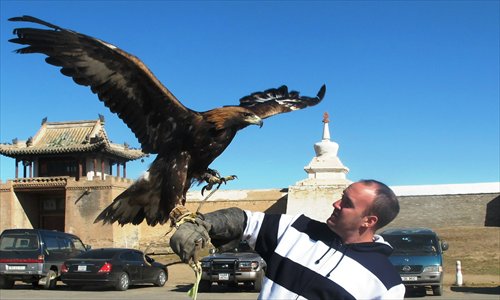
A golden eagle spreads its wings atop the author's outstretched arm. Photo: Chris Dalby/GT
The results of a straw poll among my friends about the idea of traveling to Mongolia were evenly divided in two camps. The first was an uncomprehending look followed by various surprised grunts. For these sad, unadventurous milquetoasts, Mongolia is a country one simply never contemplates going to, not because of danger but because of remoteness. The second was an outburst of excitement and encouragement. For these intrepid and audacious souls, Mongolia represents one of the boundaries of travel, a civilization that echoes through history and one of nature's wildest redoubts.
As my worthy American friend Liz and I chugged out of Ulan Bator in a rickety Russian minivan, accompanied by our guide Bolor and driver Arban, we passed the various stages of Mongolian urbanization. From the city's few fully built-up streets, we passed through shantytowns of corrugated iron, then slums of yurts housing the latest arrivals to the capital, then entered the grasslands.
Out on the plain
I know of no accurate way to convey the immensity and otherworldliness of the steppe. Thousands of miles of plains, dotted with the odd mountain range, sweep from the shores of Lake Baikal to the Gobi Desert. We were seduced not two hours after leaving the fairly nondescript Ulan Bator, in which we were told to stock up on essentials such as bottled water, snacks, and medical supplies. While there are towns of a few hundred people scattered across the Mongolian grasslands, they are few and far between, and a breakdown can see you stranded for a while.
We had arranged for an eight-day drive through central and western Mongolia. Our guide spoke functional English and was in charge of arranging our stays with various families along the way. When traveling in rural Mongolia, if you see a homestead with two yurts, one of them is set aside for guests. Park your vehicle some distance away, announce yourself by shouting "Nokhoi khorioroi" (Call off the dogs!) and proceed slowly to the door. That call is not a mere tradition, Mongolian farms deal with a number of wild animals and often own huge mastiffs which tourists are advised not to try and pet.
Ancient remains of an empire
Our first stop was near the ancient fortress of Karakorum, 400 kilometers west of Ulan Bator, the base from which Genghis Khan invaded China's Central Plains. Little remains of the fortress today, apart from a few sculptures and bas-reliefs, but the temple of Erdene Zuu stands watch nearby as a worthy guardian. The temple is surrounded by a wall of large, gleaming white stupas which stretch away across the plain. We stopped off at a rest camp nearby and approached Erdene Zuu near sunset, the dying rays lengthening our shadows along the road. Absolute silence reigned, and as the wind blew, a feeling of eerie wonder came over us at our first glimpse of the history of the ancient Mongols.

Copyright ©1999-2011 Chinanews.com. All rights reserved.
Reproduction in whole or in part without permission is prohibited.